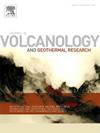Microlitic crystal-venting episodes at two trachytic lava domes of the Chaîne des Puys (France): Description, experiments and modelling.
IF 2.3
3区 地球科学
Q2 GEOSCIENCES, MULTIDISCIPLINARY
Journal of Volcanology and Geothermal Research
Pub Date : 2025-03-18
DOI:10.1016/j.jvolgeores.2025.108319
引用次数: 0
Abstract
We document and propose plausible explanations of microlite-rich pyroclastic density currents (PDCs) that ended the main effusive phases of two highly porous trachytic domes: the Puy de Dôme and Grand Sarcoui (Quaternary volcanic field of the Chaîne des Puys, France). At both volcanoes, these PDCs are evidenced by thick, unique pyroclastic deposits that originated from a late summit, open-vent eruption. These deposits are mainly composed of microlitic feldspar laths that are either free or weakly cohesive with some traces of glass. We present HP-HT crystallization experiments to constrain the pre-eruptive conditions. In these experiments, the initial water content of the material is a crucial parameter since the trachytic domes of the Chaîne des Puys exhibit the highest pre-eruptive H2O contents ever reported for alkaline liquids in an intraplate continental context. Our observations and textural and experimental results lead us to propose three models able to explain the occurrence of a microlite suspension at depth after the initial construction of a dome. Model 1 and Model 2 explore the scenario of gas accumulation within the conduit, or at the upper part of the reservoir; Model 3 explores the scenario of gas accumulation below a shallow impermeable plug. Whereas the highly porous nature of the trachyte must have favored gas escape preventing any explosivity of the dome itself during its early growth, the late explosive phase that generated the crystal-rich PDC points to an excess pressure due to drastic porosity reduction of the trachyte above the accumulated mush. We expect that it is the result of the combination of void collapse caused by depressurization and nearly complete outgassing, and pervasive silicification leading to an impermeable carapace. The results of both Models 1 and 2 call for a sector collapse that causes the final pressure drop and conduit evacuation. Since sector collapses at domes are common, the rarity of such microlitic ash deposits could partly be explained by the low viscosity that characterizes these uncommon trachytic melts. Model 3 results suggest that a specific thickness of sealed magma could be the feeding conduit, or alternatively a lateral shallow intrusion of magma of specific dimensions that accumulates gas below an impermeable cap, which can be either roof rocks or cristobalite precipitation within the upper part of the sill. The available data do not allow us to favor any of the models — or a combination thereof if we do not suppose a unique mechanism operating at both volcanoes.
法国cha ne des Puys两个粗溶熔岩穹丘的微晶晶体喷发:描述、实验和模型。
我们记录并提出了富含微岩的火山碎屑密度流(PDCs)的合理解释,这些密度流结束了两个高度多孔的粗裂圆顶的主要涌出阶段:Puy de Dôme和Grand Sarcoui(法国cha ne des Puys的第四纪火山场)。在这两座火山上,厚而独特的火山碎屑沉积物证明了这些PDCs的存在,这些火山碎屑沉积物起源于山顶晚期的露天喷发。这些矿床主要由微晶长石板条组成,这些板条要么是自由的,要么是弱粘性的,并带有一些玻璃痕迹。我们提出了HP-HT结晶实验来限制喷发前的条件。在这些实验中,材料的初始含水量是一个关键参数,因为cha ne des Puys的粗裂圆顶在板内大陆环境中显示出最高的喷发前水含量。我们的观察以及纹理和实验结果使我们提出了三个模型,能够解释圆顶初步建造后深层微岩石悬浮的发生。模型1和模型2探讨了天然气在管道内或储层上部聚集的情景;模型3探讨了浅层不透水塞下的天然气聚集情况。然而,气管组织的高多孔性肯定有利于气体逸出,从而防止圆顶在早期生长过程中发生爆炸,而产生富晶PDC的爆炸后期表明,由于累积的黏液上方的气管组织孔隙度急剧减少,导致压力过高。我们认为,这是由于减压和几乎完全除气引起的空洞塌陷,以及普遍的硅化导致的不透水外壳的综合结果。模型1和模型2的结果都认为扇形坍塌会导致最终压力下降和管道疏散。由于圆顶的扇形崩塌很常见,这种微晶灰渣沉积物的罕见可以部分地解释为这些罕见的粗溶性熔体的低粘度特征。模型3的结果表明,特定厚度的封闭岩浆可能是供气管道,也可能是特定尺寸的岩浆侧向浅层侵入,在不透水的盖层下积聚气体,这些盖层可以是顶岩,也可以是储层上部的方英石沉淀。现有的数据不允许我们支持任何一种模型,或者如果我们不假设两个火山都有独特的作用机制,也不允许我们支持它们的组合。
本文章由计算机程序翻译,如有差异,请以英文原文为准。
求助全文
约1分钟内获得全文
求助全文
来源期刊
CiteScore
5.90
自引率
13.80%
发文量
183
审稿时长
19.7 weeks
期刊介绍:
An international research journal with focus on volcanic and geothermal processes and their impact on the environment and society.
Submission of papers covering the following aspects of volcanology and geothermal research are encouraged:
(1) Geological aspects of volcanic systems: volcano stratigraphy, structure and tectonic influence; eruptive history; evolution of volcanic landforms; eruption style and progress; dispersal patterns of lava and ash; analysis of real-time eruption observations.
(2) Geochemical and petrological aspects of volcanic rocks: magma genesis and evolution; crystallization; volatile compositions, solubility, and degassing; volcanic petrography and textural analysis.
(3) Hydrology, geochemistry and measurement of volcanic and hydrothermal fluids: volcanic gas emissions; fumaroles and springs; crater lakes; hydrothermal mineralization.
(4) Geophysical aspects of volcanic systems: physical properties of volcanic rocks and magmas; heat flow studies; volcano seismology, geodesy and remote sensing.
(5) Computational modeling and experimental simulation of magmatic and hydrothermal processes: eruption dynamics; magma transport and storage; plume dynamics and ash dispersal; lava flow dynamics; hydrothermal fluid flow; thermodynamics of aqueous fluids and melts.
(6) Volcano hazard and risk research: hazard zonation methodology, development of forecasting tools; assessment techniques for vulnerability and impact.

 求助内容:
求助内容: 应助结果提醒方式:
应助结果提醒方式:


